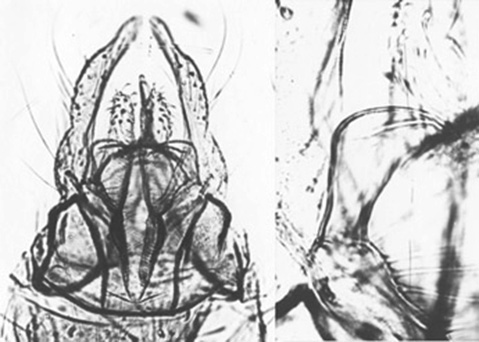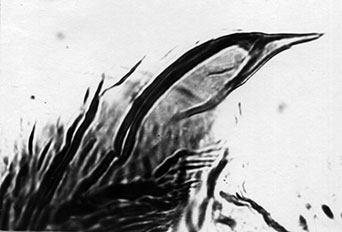Species 2c. C. species pararipariusAdult:
Specimens, including rearings, in the collection of J.E. Sublette, now in the Zoological Museum of the University of Minnesota, St. Paul.
Male:Originally only available information was photographs of the terminalia and superior volsella (below), but further description provided by Namayandeh et al. 2024 (who only state their specimen is nr. sp. parariparius. Further specimens or data would be required to confirm whether these specimens are from a single species.
AR 3.1; frontal tubercle 12 µm long.
Wing unpatterned; 1 seta on brachiolum, 17 setae in squamal fringe.
Leg lengths and ratios (foreleg only)
| Fe
| Ti
| Ta1
| Ta2
| Ta3
| Ta4
| Ta5
| LR
| F/T
| Ta4/Ti
| PI
| 1552
| 1328
| 2144
| 1216
| 903
| 722
| 338
| 1.6
| 1.16
| -
| 
Male terminalia of C. sp. 2c (left)
with S-type superior volsella (right)Setae on TIX, about 6, probably in individual [ale spots in a roughly triangular pale area with its apex towards the anal point. Superior volsella closest to S(a) of Strenzke (1959); Inferior volsella reaching almost to the end of the anal point which reaches at least halfway along the gonostylus and appears narrower at base; gonostylus relatively narrow and narrowing markedly over posterior third. Pupa: Caudolateral spur of segment VIII with about one spine.

Pupal spur of C. sp. 2cFourth instar larva a small to medium thummi-type (Fem. 13.7 (13.1-14.3) mm; Male abt 10.7 mm) with ventral tubules relatively short, about equal length or posterior pair longer (ant. 1.03 (0.7-1.2) mm; post. 1.04 (0.8-1.3) mm). Gular region and frontoclypeus pale or gula may be slightly darkened.
Anal tubules 326-366 µm long, 130-135 µm wide (2.4-2.8 times longer than wide).
Salivary reservoir about 77 (58-86) µm long and 3-4.5 times longer than wide.
Mentum (Fig. d)with generally sharp teeth; c1 tooth narrow, almost as long as first laterals, c2 teeth well formed and separated (type III); 4th laterals not reduced (type I).
Pecten epipharyngis (Fig. a)with about 12 somewhat irregular sharp teeth - essentially type B but with occasional small teeth. Teeth of premandible (Fig. c)about equal length, with inner tooth about 2.3-3.7 times wider than the outer.
Antenna (Fig. b) with basal segment quite long, almost half the ventral head length and about 5 times longer than wide, RO about 0.4 up from base; AR about 2.43 (2.28-2.68); antennal proportions (micron) 147 : 33 : 10 : 10.5 : 7.5.
Distance between antennal bases greater than that between S4 setae, which occupy about 0.72-0.89 of the width of the frontoclypeus; S5 setae slightly posterior to the adjacent RO.
Mandible (Fig. e)with 3rd inner tooth separated and darkened (type II-IIIB), about 14-16 furrows on outer surface near base and 11 (9-12) taeniae in Pecten mandibularis; Mdt-Mat 15-23, MTR 0.24-0.33. Cytology: 4 polytene chromosomes with the pseudothummi arm combination AE, BF, CD, G. Chromosomes relatively short and often with sections unpaired.
Arm G generally unpaired or may be paired at the subterminal nucleolus and submedian Balbiani ring (BR); but occasionally fully paired as in figure. Centromere heterochromatic, arm often constricted between the nucleolus and BR. No nucleoli in the long chromosomes and centromeres not markedly heterochromatic. No polymorphism in specimens examined. Found: Ontario - Glen Tay. Snow melt pools. See also C. sp. f, C. sp. y, and C. sp. 2e.| Return to Index| Go to References ] |

